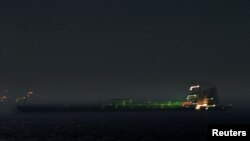An Iranian oil tanker pursued by the U.S. on Friday again listed its destination as Turkey but the Turkish foreign minister added to the confusion by saying the vessel is headed to Lebanon — statements that were promptly denied in Beirut.
The flurry of contradictory statements further muddies the waters for the Adrian Darya 1, formerly known as the Grace 1, and obscures where its 2.1 million barrels of oil will ultimately go.
The tanker has taken center stage recently amid a crisis roiling the Persian Gulf and escalating tensions between Washington and Tehran after President Donald Trump unilaterally withdrew America from Iran's 2015 nuclear deal with world powers over a year ago. The vessel's detention and later release by Gibraltar has fueled the growing tensions.
The tanker on Friday changed its listed destination in its Automatic Identification System to Iskenderun, Turkey, a small port on the Mediterranean Sea.
However, mariners can input any destination into the AIS, so Turkey may not be its true destination. On Aug. 24, it had listed its destination as Mersin, Turkey, before removing that from its system. Earlier, it had said it was going to Greece.
Iskenderun is some 200 kilometers (125 miles) by sea from a refinery in Baniyas, Syria, where authorities alleged the Adrian Darya had been heading before being seized off Gibraltar in early July.
Iranian state media and officials did not immediately acknowledge the new reported destination of the Adrian Darya, which carries Iranian crude worth some $130 million.
Turkey's Foreign Minister Mevlut Cavusoglu denied the tanker was heading to Iskenderun and claimed it was going to Lebanon. Speaking in Oslo, Norway, the diplomat said the Turkish state and Turkish private companies were no longer buying oil from Iran, in line with U.S. sanctions.
``This tanker is not heading actually to Iskenderun port, this tanker is heading to Lebanon. And we follow actually very closely ... it is heading to Lebanon,'' the minister said.
But Lebanon's Minister of Energy and Water Nada Boustani tweeted that was not the case and that there is no request for the tanker to enter Lebanon. She also said Lebanon does not have a refinery to deal with crude oil.
Since Trump pulled America out of Tehran's nuclear accord with world powers, Iran has lost billions of dollars in business deals allowed by the deal as the U.S. re-imposed and escalated sanctions on Tehran, largely blocking Iran from selling crude oil aboard, a crucial source of hard currency for the Islamic Republic.
In U.S. federal court documents, authorities allege the Adrian Grace's true owner is Iran's Revolutionary Guard, a paramilitary organization answerable only to Supreme Leader Ayatollah Ali Khamenei. The U.S. declared the Guard a foreign terror organization in April, the first time America named a military force of a nation as such, giving it the legal power to issue a warrant for the vessel's seizure. However, that would require another nation to acknowledge the writ.
On Monday, Iran said the oil on the Adrian Darya had been sold to an unnamed buyer. However, anyone buying it likely would be targeted by U.S. financial sanctions. Analysts have suggested Iran may choose to offload the oil onto another ship first, given the international attention focused on the Adrian Darya.







